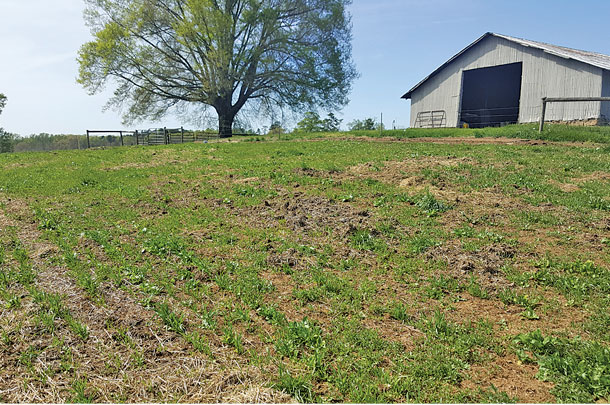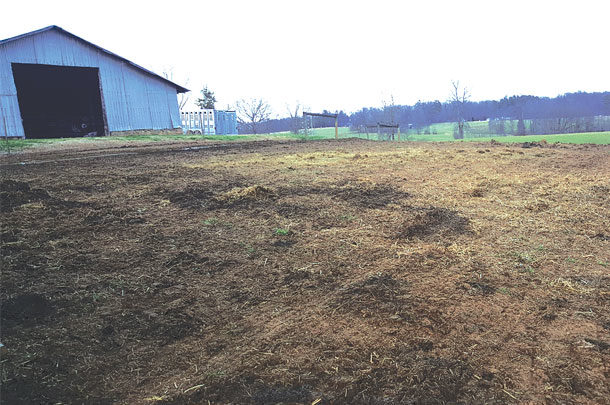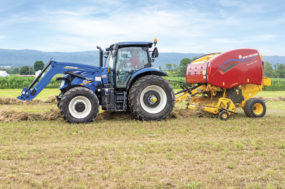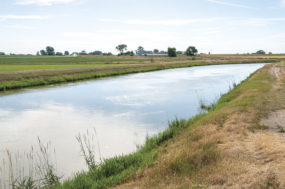By having a plan for winter-feeding area renovations, we can rest easy knowing those areas can still be productive after the weather stops being frightful.
Soil preparation
If the precipitation we receive this year is anything like last year, we know one thing for sure: We are going to have to do some ground work to smooth things out before seeding. Prepping the soil after months of wet weather and pugging is the foundation of any renovation plan. After the soil dries out a bit, using a harrow, disk, box blade or other equipment may be necessary to smooth out equipment ruts and loosen compacted areas from repetitive equipment and hoof damage.
Utilizing a method of deeper tillage may also be necessary if months of hay feeding has led to a thick layer of thatch on top of the ground or if a large seedbank of weed seed is expected to germinate. Keeping hayfields clean of weeds or purchasing hay from a trusted source is key in preventing troublesome weed species from invading your winter-feeding areas.
Choosing a forage species

There are several forage options that can be utilized to mend damaged pasture areas. Choosing a forage species based on an immediate and long-term forage plan will ultimately save you money and keep you from having many sleepless nights. When developing this plan, first start with a historic look into your winter-feeding areas. Do you find yourself feeding and damaging the same area year after year? Or do you move your feeding area around from one location to another? Do you occasionally or rarely have an area that needs attention in the spring? Knowing this information can help you decide whether to plan for an annual or perennial forage establishment.
Repeatedly having a distressed area would indicate the need for an annual forage that is quick to establish to stabilize the soil and provide rapid growth so as to not lose forage productivity in that area. On the other hand, reestablishing an occasional winter-feeding area with a perennial forage that can withstand some hoof traffic, such as tall fescue or bermudagrass, may be the best option for long-term stability.
Annual forages are a great option for areas that have repeated damage. Late winter or early spring plantings of cereal rye, spring oats or annual ryegrass can be utilized as a source of emergency forage and may help reduce a few weeks of hay feeding. However, spring-planted winter annuals often produce less tonnage than fall plantings.
Summer annual forages are also another great option for winter-feeding areas. Forages such as sorghum-sudangrass hybrids, pearl millet, cowpea, brassicas, crabgrass and sunn hemp grow rapidly and can both stabilize the soil and help smother out summer annual weeds. These forages can be both drilled and broadcast, but getting good seed-to-soil contact is key to any successful forage establishment.
When using a broadcaster, prepping the soil with one of the previously discussed methods and/or using a cultipacker can ensure the seed comes into contact with the soil. Even if you do not have access to a drill or broadcaster, there are several creative methods to still get the seed dispersed. Dr. John Jennings at the University of Arkansas once suggested drilling holes in a milk jug and using it as a broadcast “shaker,” and I have had success using this method in small winter-feeding areas in the past.
Spring is a great time to establish bermudagrass or bahiagrass, but reestablishing cool-season perennial grasses during this time can be difficult. Summer annual weeds have a competitive advantage over tall fescue and orchardgrass, and there are no herbicide options available until forages reach the four- to five-leaf stage, which can easily be delayed by early season droughts.
An additional option for establishing cool-season perennials is to use a summer annual forage in damaged areas to smother out weed species and help alleviate compacted soils before planting the cool-season perennial forage in the fall of the year. Any of the previously mentioned summer annual forages can be used to meet these goals, but using crabgrass may be antagonistic to a successful fescue or orchardgrass establishment. Crabgrass is a prolific seed producer during the fall, and this seedbed may germinate and cause competition during the first summer of the establishment year. Therefore, sticking to a sorghum-sudangrass hybrid, pearl millet, sunn hemp, cowpea, brassica or a mixture of species may be the best option.
Fencing for efficiency
Lastly, planning to fence livestock out of the winter-feeding area until the annual or perennial forages are ready to graze will help promote healing of the area and prevent damage to the immature stand. This can be accomplished by utilizing temporary fencing. If livestock have not been trained to polywire, utilizing at least two strands and ensuring the fence is hot will keep animals away. The temporary fencing can also be used as a grazing tool to allow better grazing control of the winter-feeding area.
Creep grazing can be accomplished by setting a single strand of polywire high enough to allow calves to slide under and consume the high-quality forage while keeping the cow herd out from the area. Polywire can also be used to strip-graze the area to get a higher efficiency of use.
One problem we often see with winter-feeding areas is the high concentration of nutrients being deposited in that area. Flash grazing the winter-feeding area for a few hours and then removing the livestock from the area with temporary fencing is a great way to disperse nutrients around the farm.
No matter what Mother Nature brings us this year, having a winter-feeding area renovation plan will help us be prepared to quickly get those acres back in shape this spring.
Wishing you all a prosperous forage year! ![]()
PHOTO 1: Winter-feeding area seeded with spring oats, turnips and radish
PHOTO 2: A winter-feeding area after soil preparation with a pasture drag. Photos by Johnny Rogers, Amazing Grazing, NC State University.

-
Deidre Harmon
- Extension Assistant Professor and Mountain Livestock Specialist
- North Carolina State University
- Email Deidre Harmon










